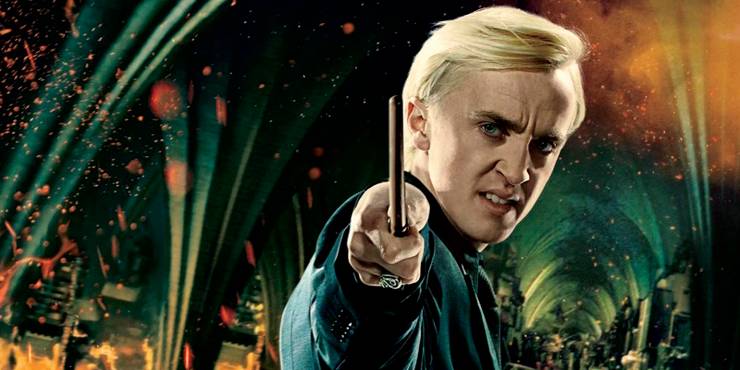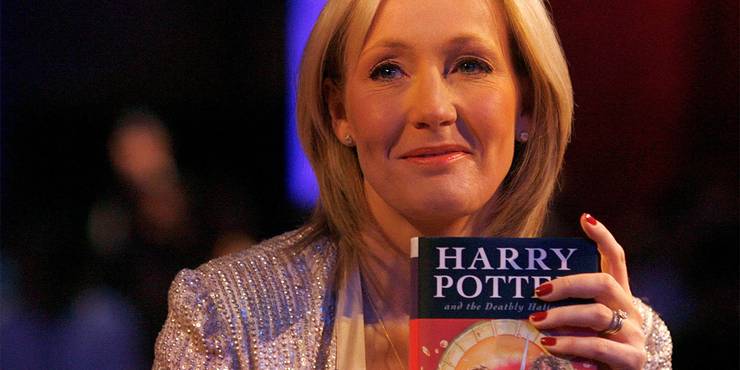Harry Potter: 15 Things About Harry’s Scar Only True Potterheads Know

Harry Potter’s distinctive, lightning bolt-shaped scar is arguably the most well-known facial blemish in all of modern pop culture. The result of dark wizard Lord Voldemort’s failed attempt to do away with the boy wizard as a baby, the scar – coupled with a pair of eyeglasses, naturally – has come to represent a shorthand way of referring to the character.
Over the course of seven Harry Potter novels, eight film adaptations, the Cursed Child stage show and numerous interviews, series creator JK Rowling has divulged plenty of interesting tidbits relating to Harry’s scar. For most people, a scar is little more than a permanent physical memento of an unfortunate scrape – but for The Boy Who Lived? Let’s just say it’s a lot more significant than that.
Sure, more casual Harry Potter fans will know the story of how Harry received his scar – and that it marks him as the Chosen One destined to face Voldemort in a winner-takes-all showdown. As it turns out, that’s barely scratching the surface of the true nature, significance and behind-the-scenes shenanigans attached to Harry’s most recognizable feature.
With this in mind, we’ve pulled together this list of 15 Things About Harry’s Scar Only True Potterheads Know.
15 There’s A Reason Why It’s Lightning Bolt-Shaped

As facial scars go, Harry could be doing a lot worse. Seriously: what could be more awesome than a scar in the shape of a lightning bolt? True, the cost of said scar was way more than anyone would ever willingly pay – after all, Voldemort cold-bloodedly dispatched Harry’s parents before attempting to curse him.
Still, there’s no getting around the fact that it’s easily the most aesthetically-pleasing disfigurement ever inflicted upon anyone.
That said, you might be wondering if there’s a specific, in-universe reason why Harry’s scar resembles a bolt of lighting (other than “because magic”) – and there is.
Thanks to Pottermore, we know that the wand motion used to cast the Avada Kedavra curse corresponds exactly to the lightning bolt shape that adorns Harry’s forehead.
The obvious implication here is that, although the spell rebounded on Voldemort, the minor wound it left perfectly mirrored the movements used by the Dark Lord to invoke its magic.
That’s the canonical rationale for Harry’s scar looking the way it does, but is there a real-world explanation? Well, it turns out we’re not the only ones who think that a lightning bolt scar looks cool – JK Rowling does as well!
The author has admitted as much in interviews, acknowledging that she wanted her hero to sport an awesome-looking reminder of his first encounter with Voldemort, finally settling on the now-iconic shape.
14 It Symbolizes His Internal Suffering

Harry’s scar is an ever-present reminder of the physical hardship that he has endured since he was an infant – but it also symbolizes more than that, too. Comments by JK Rowling indicate that the scar is also meant to signify the boy wizard’s internal ordeals, as well.
Obviously, losing one’s parents at a very early age – and then being placed in the care of relatives who are, quite frankly, just the worst – is going to result in a considerable degree of emotional anguish. Harry’s scar is intended as an outward marker of this inner suffering – a way for the author to subtly communicate our hero’s ongoing, unspoken struggles.
Rowling also notes that Harry’s scar is a metaphorical way of branding the Boy Who Lived as both “chosen” and “cursed,” to some extent. This makes sense, as the lightning bolt-shaped cicatrix ties into both the positive and negative aspects of the prophecy surrounding Harry and Voldemort.
This prophecy foresaw that Voldemort would inadvertently anoint (or “chose”) the child capable of destroying him. It also proclaimed that this child would be ruthlessly pursued by the Dark Lord as a result, until only one of them survived – which we think you’ll agree definitely constitutes being “cursed!”
13 A Fragment Of Voldemort’s Soul Is Responsible For The Pain It Causes

Easily the biggest downside to Harry’s otherwise awesome-looking scar is the splitting migraines it has caused the boy wizard over the years. This pain is chalked up to the unique connection shared between Harry and Voldemort, forged when the Dark Lord accidentally transformed his hated enemy into a soul fragment receptacle called a “Horcrux”.
Thanks to this unwittingly established bond, Harry is able to sense Voldemort’s moods and even read his thoughts – which, while something of a mixed blessing, has come in handy at times. The downside to this phenomena is that more often than not – most notably, when the Dark Lord is in a deadly rage – Harry’s scar throbs with pain for the entire duration.
Interestingly, JK Rowling has revealed that there’s more to these splitting headaches than just “Voldemort is thinking mean thought.s. No, it turns out that the source of this intense discomfort is the piece of Voldemort’s maimed soul that resides within Harry.
Given the intensity of the Dark Lord’s feelings, it’s no surprise that his soul shard is able to sense them via his connection to Harry.
Upon making contact – albeit indirectly – with Voldemort, the soul fragment immediately desires to be reunited with its owner, and forcefully tries to escape Harry’s body via his scar!
12 It’s Not In The Center Of Harry’s Forehead

Everyone knows that Harry’s scar is located on his forehead – but exactly where on his forehead is a subject of some confusion. As with many hotly debated topics in Harry Potter canon, the issue here stems from a discrepancy between the books and the movies.
However, this may well be the only instance where JK Rowling has recognized the film franchise as being closer to her vision for the character than the books.
See, the cover art for both the US and UK editions of the Harry Potter novels generally depicts Harry’s scar as near the center of his forehead – especially the covers by Mary GrandPré, which always place it smack bang in the middle.
Conversely, in the Harry Potter movies, actor Daniel Radcliffe displays his (prosthetic) lightning bolt blemish directly above his right eye. Why is it so off-centrer? Because that’s where Rowling told the filmmakers it belonged!
Funnily enough, the author never explicitly specifies in the books themselves where on Harry’s forehead his scar can be found. That said, there are clues – such as a reference to Harry feeling a stab of pain above his right eye in Order of the Phoenix – that confirm that Rowling had its askew alignment in mind when crafting the series.
11 Malyfoy’s ridiculous nickname for it

Like many of us, Harry Potter has accrued more than his fair share of nicknames – some good, and some not so good. Of these, the first and most positive is “The Boy Who Lived,” which was bestowed on him as a baby after he survived the attempt on his life by Voldemort.
This moniker – which was adopted by the entire Wizarding community – didn’t simply celebrate Harry’s miraculous escape, but the Dark Lord’s subsequent (temporary) downfall, as well.
Then there’s “The Chosen One,” which was essentially foisted on Harry by the Daily Prophet (with the backing of the Ministry of Magic) to boost public morale. Even if the boy wizard was never entirely comfortable with this title – which grossly over-simplifies the nature of the Harry/Voldemort prophecy, we might add – at least it was typically used in a well-meaning sense.
On the flipside, labels like “Undesirable No. 1” – which applied to Harry when he was a fugitive from the Voldemort-controlled Ministry – are decidedly less well-meaning.
What does all this have to do with Harry’s scar, you ask? Well, as it happens, said scar served as the inspiration behind arguably the least imaginative of any of Harry’s nicknames.
In Chamber of Secrets, Harry’s bitter rival Draco Malfoy – obviously running low on quality material – resorts to calling Harry “Scarhead”, which is just lame.
It certainly didn’t cause Harry to break his stride, as he went on to win the Quidditch match against Slytherin shortly after.
10 It Did Hurt Again After Voldemort’s Demise

When Harry Potter and the Deathly Hallows was released back in 2007, JK Rowling expressed no desire to continue the story of everyone’s favorite boy wizard. So when the author responded to a question about Harry’s scar during a webchat soon after the final volume was published, the impact her response would have on any potential sequels wasn’t even a factor.
Some asked whether the scar ever caused Harry discomfort again following Voldemort’s downfall in Deathly Hallows. The epilogue of the book makes it clear that Harry’s forehead has been pain-free for 21 years since the Battle of Hogwarts – but what about after that?
Rowling’s response was no, Harry’s scar never troubled him ever again, once the Dark Lord shuffled off this mortal coil. This makes sense, too – as we’ve already covered, the pain Harry experienced was caused by a fragment of Voldemort’s soul, which he ultimately rid himself of late in Deathly Hallows.
All this went out the window when Rowling conceived the idea for follow up stage show Harry Potter and the Cursed Child, however.
The Cursed Child portrays an adult Harry feeling that old familiar sting, in response to efforts made to resurrect Lord Voldemort.
How is this possible? Well, we’re loathe to call this out as a massive plot hole, but seriously: the only other explanation we can think of is “magic?”
9 It’s Not His Only Prominent Scar

A life filled with adventure is simultaneously a life beset with physical peril – for evidence of this, consider Harry Potter’s mark-covered body. In addition to the scar on his forehead – which he’s carried with him since he was only one year old – the boy wizard has several other prominent reminders of his many near-fatal scrapes.
Although none of these scars is as idiosyncratic as the lightning bolt that adorns Harry’s melon, a couple come close. Take the disfigurement on the back of his right hand, which spells out “I must not tell lies” in handwritten script. This came from Dolores Umbridge – more specifically, from her enchanted quill, which magically carved the detention lines he wrote on parchment into his flesh.
There’s also an oval-shaped burn on the Boy Who Lived’s chest, left by Salazar Slytherin’s Locket. At the same time he was branded by the locket, Harry was bitten by the snake Nagini, too – and this presumably left a scar behind, as well. Hermione Granger treated these injuries with a dittany-based potion, which kept the wounds clean and closed. Unfortunately, there are limits to dittany’s healing properties, and the scars from both almost certainly never fully disappeared.
More recently, Pottermore reported that the adult Harry was seen with a cut over his right cheekbone, which is certain to leave a scar. The origins of this disfigurement remain a mystery, but it’s likely related to his work for the Department of Magical Law Enforcement.
8 It Was The First Clue To His Connection With Voldemort

Dumbledore was a very clever guy – it’s part of the reason why he’s considered one of the greatest wizards of all time. Somebody with his immense amount of brainpower doesn’t need much more than the vaguest of hints to pull together a fully-fledged – not to mention accurate – theory.
Harry’s scar is a perfect example of Dumbledore’s knack for using a minor clue to tease out a major, game-changing revelation. In Order of the Phoenix, Albus divulges that the moment he first saw the lightning bolt-shaped cut on baby Harry’s head, he instantly surmised that it signified a lasting connection between the boy wizard and Voldemort.
Fast forward 15 years, and Dumbledore’s guess was proven correct, when a unique mental (and spiritual) bond was discovered to exist between Harry and the Dark Lord. Now, lesser wizards would have chalked up Harry’s increasingly surly, temperamental demeanour solely to him being a teenager.
Thanks to the scar, Dumbledore knew that Harry’s volatile moods were (at least partly) an indication that Voldemort was capable of reading – and even invading – the Boy Who Lived’s mind. Armed with this knowledge, Dumbledore was able to take steps to guard against a possessed Harry compromising the heroic efforts of the Order of the Phoenix – although it did mean keeping the poor kid at arm’s length.
7 It Can’t Be Removed By Magical Means

Wizarding medicine is downright spectacular, and is generally capable of remedying debilitating conditions far more effortlessly than its Muggle counterpart. Often times, magical cures can heal patients without leaving so much as the slightest scar – and can even be used to reverse the scarification process.
That said, there are limits to what the doctors and nurses at St Mungo’s Hospital for Magical Maladies and Injuries can accomplish in the medical field. This extends to disfigurements – sometimes, when the wound involved is severe enough, it’s going leave a permanent mark no matter how many spells and potions you throw at it.
Multiple characters throughout the Harry Potter series sport scars that weren’t able to be removed by magic.
Two of the brothers of Harry’s best mate Ron – Bill and George – suffered magical injuries that fall into this category. Bill was badly maimed by the werewolf Fenrir Greyback, and George lost an ear when he bore the brunt of a particularly potent curse. Then there’s famed Auror Mad-Eye Moody, who ended up with a pock-marked, patchwork quilt of face reflective of years spent duelling on the front lines.
Of course, Harry and his scar fall under this umbrella, too. Early on in Harry Potter and the Philosopher’s Stone, Professor Dumbledore makes it clear that the boy wizard’s scar cannot ever be mended – even by magical means.
6 It’s The Only Physical Wound Ever Left By Avada Kedavra

In the Harry Potter books and movies, a big deal is made about the Avada Kedavra curse causing its victims to snuff it without inflicting any internal or external marks on its victims. We see this numerous times throughout the series – Harry’s parents, Voldemort’s muggle relatives, Professor Dumbledore and many others meet their end without a single scratch to show for it.
That’s what makes the spell so evil: its ability to instantly – and in nearly all circumstances, unstoppably – end a life.
However, Avada Kedavra can be evaded, if the intended target is incredibly lucky. They might rely on their reflexes to avoid the deadly jet of green light before it makes contact with them – either leaping out of the way or taking cover nearby. They can also deflect the curse with a spell of their own – although this requires unbelievably precise aim and timing.
In very rare circumstances, they can be saved by the “Priori Incantatem” effect. This the joining together (and nullifying) of spells when two wands with the exact same core material are used against each other.
Crucially, in all these circumstances, the intended victim isn’t actually hit by Avada Kedavra – they evade it.
Harry Potter is the only known directsurvivor of this curse.
This also affords him the dubious honor of being the only person ever physically injured by the spell, in the form of the lightning bolt-shaped gash on his forehead.
5 It Was Supposed To Be The Last Word In The Series

JK Rowling had the overall narrative for all seven Harry Potter novels planned out far in advance of sitting down to actually write each individual book. That’s how she was able set-up so many plot threads early on in the series, only for them to pay off further down the line.
Sure, things changed along the way – like how Ron’s father Arthur was set to lose his life in Order of the Phoenix, only to be spared by the author at the eleventh hour. But by and large, everything pretty much went down the way Rowling originally mapped it out.
As you’d expect given the intricate plotting that characterizes the books, Rowling prepped many chapters in impressively granular detail – to the point of even roughing out some of the prose. Famously, this included the epilogue of Harry Potter and the Deathly Hallows, with the author long maintaining in the lead-up to its release that the final word would be “scar.”
Right up until the final revisions on Deathly Hallows, the last word in the series did indeed refer to Harry’s iconic facial blemish.
Ultimately, Rowling decided to re-work the text to more clearly convey her intended meaning, and Deathly Hallows wraps up with the word “well” instead.
4 It Was Added To Stained-Glass Windows In The First Movie

Part of the joy of being a crewmember on a blockbuster film series like the Harry Potter franchise is sneaking in goofy background gags. These fun little inclusions aren’t intended to call attention to themselves – after all, if they were easily noticed, they would distract the audience – but provide an extra layer of detail for eagle-eyed fans.
One such in-joke can be seen on the Marauder’s Map prop introduced in Harry Potter and the Prisoner of Azkaban. Here, the visual effects artists responsible for animating the Map’s magical surface intentionally misspelled the name “Moony” as “Mooney”. Why did they knowingly commit this error? As a shout-out to their boss, visual effects supervisor Karl Mooney, of course!
On the whole, however, these gags are usually much harder to spot – and more than a few don’t even make it on-screen. Such was the case with a cheeky tip of the hat to Harry Potter’s famous scar, which was (temporarily) added to the windows of Gloucester Cathedral.
Before shooting began on Harry Potter and the Philosopher’s Stone, the film’s set dressers were tasked with transforming the Cathedral – which doubled as Hogwarts – into a more “magical” environment. This extended to its ornate stained-glass windows, with alterations made including adding wizarding clothing to Adam and Eve – as well as lightning bolt scars for good measure.
3 It Changes Position Throughout The Movies

As we’ve already explained previously, it’s actually the Harry Potter movies (and not the books’ cover artwork) that gets the placement of the boy wizard’s scar correct. At the same time, across all eight movies in which Harry appears, that little lightning bolt never appears in quite the same part of his forehead every time.
This shouldn’t come as much of a shock, when you think about it. The make-up artists who worked on the franchise were required to re-apply the scar prosthesis to the faces of actor Daniel Radcliffe and his stunt doubles a gob-smacking 5,800 times in total.
As such, despite the very best of efforts to maintain continuity, it’s totally understandable that Harry’s scar – while still remaining above his right eye – would move slightly between scenes.
Given that each Harry Potter flick was filmed out of order, this does lead to instances where the scar prosthesis shifts positions dramatically between shots.
All that said, without a doubt the most obvious – not to mention hardest to ignore – issue surrounding Harry’s scar on the big screen is those occasions when it’s absent. That’s right, there are a handful of brief moments scattered throughout the franchise when his scar vanishes entirely!
2 It Never Fades

In real life, most scars typically fade with age, and over time, can become far less pronounced as a result. Many fans wondered if this was true where Harry’s scar is concerned, and whether or not the boy wizard’s most distinguishing physical trait eventually became less prominent. This line of logic was driven partly by the idea that, once the magical connection between Harry and Voldemort had been severed, it would be visibly reflected by his scar becoming less clear – or disappearing altogether.
Now, it is true that once Voldemort was defeated, the powers that he had conferred upon Harry were lost forever. Did his scar likewise vanish? A careful reading of the epilogue to Harry Potter and the Deathly Hallows pretty quickly debunks this theory – Harry’s scar is definitively shown as present and accounted for 21 years later.
Did it ever fade? Nope, that’s a bust as well. The lightning bolt mark on the grown-up Harry’s head in Harry Potter and the Cursed Child is still as clearly defined as the day he arrived at Hogwarts!
In the end, it turns out that – for better or worse – Harry is destined to carry his distinctive disfigurement with him for the rest of his life.
1 It’s The Only Thing Younger Harry Liked About His Appearance

It’s fair to say that growing up living in a cupboard under the stairs, and raised by your monstrously callous aunt and uncle doesn’t do much for your self-esteem. That’s probably why the young Harry Potter – prior to discovering his magical heritage on his eleventh birthday – was plagued by some pretty major self-image issues.
Poor Harry was a short, scrawny kid – that’ll happen when you’re chronically underfed – with knobbly knees and over-sized, round glasses. As if that weren’t enough, he also sported a head of perennially unkempt, overgrown hair inherited from his father.
It’s not all that surprising to learn that the one physical characteristic upon which the Boy Who Lived prided himself on was actually his lightning bolt-shaped scar!
Not only does it look next-level cool, but it also somehow suggested to Harry that he was special – and (at least subconsciously) provided him with a link to the parents he so sorely longed for.
In the years following his arrival at Hogwarts, our hero morphed into a tall, well-nourished, handsome guy (although his mop would never be tamed), and his self-image problems largely evaporated. It’s a good thing, too: Harry gradually became self-conscious about his scar – due to the fame attached to it and the stares it drew – and no longer held such high affection for it!
—
Did we miss out any other cool facts about Harry Potter’s scar? Let us know in the comments!
About The Author

















